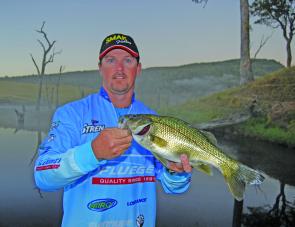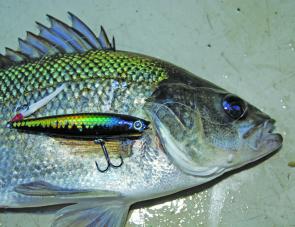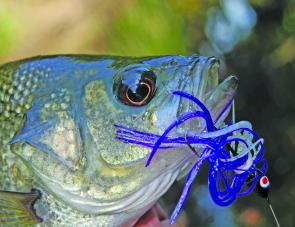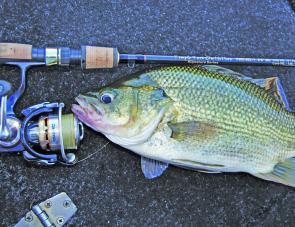It’s that time of year again, when a host of bass anglers come out of hibernation. As Spring fills the air, the good old Aussie bass captures their imagination.
Thankfully, the whole NSW up to 100km or so inland is blessed with many great rivers, creeks, lagoons and dams where bass can be found.
Some of us have been bass fishing for many years. In my case that’s over two decades but there are also many who are yet to experience what bass fishing is all about.
The first thing anyone needs when chasing a new species is the right gear for the task. So in this article we’ll run through some suitable bass tackle and other essentials that will help make the whole thing more productive and pleasurable.
Any lightweight outfit capable of casting a smallish lure can be pressed into service for bass fishing. However, some rods and reels are more suited to the game.
In the past, lure casting for bass was dominated by baitcaster reels, which were considered necessary for making accurate casts into snags or pockets where bass may be waiting.
The truth is, though, while baitcasters may be good you really can cast just as accurately with a threadline or eggbeater reel. The real key is to have a balanced outfit, which means correctly matching your rod, reel, line and lure weight so it all works as an efficient casting system.
Then, by using it a lot, your casting accuracy will improve. Always remember, practice makes perfect.
In most places, a light threadline or ‘flick stick’ outfit, as used for bream luring, will be spot-on for bass. A reasonable quality rod around 6’ to 7’ with a light whippy tip, teamed up with a 1500- to 2000-size threadline will do a good job.
In places that are particularly snaggy or where really big bass are likely, it may pay to use a slightly stiffer rod and a 2000- to 2500-size reel. Light tackle, snags and big bass mean too many bust-ups, lost lures and poor fish swimming around with lures stuck in their gobs – not good.
By all means, use a baitcaster if you prefer but if you’re new to bass fishing I thoroughly recommend threadline tackle. You’ll encounter fewer problems and be able to just concentrate on hooking fish.
Bass enthusiasts are known for their love of lures and a lot of anglers have rather large collections. While that may sound impressive, it’s certainly not necessary.
To get started you can probably get away with about a dozen lures. A mix of about six diving crankbaits, three surface lures and three spinnerbaits will catch you a lot of bass in a range of different environments.
Only a very small tackle box is required to house a small number of lures like this, so it would be very convenient to throw in a bag or backpack for walking along a river or stowed in a kayak. Once you start to see which lures work best for you, more can be added through the season.
I have a modest collection of lures and use all of them at one stage or another, but I leave the big boxes at home when I fish. For just a few hours on the water, or even a full day, there’s really no need to haul along large boxes when you’re probably going to be using only half a dozen or so.
What I do is take out a few reliable favourites and a couple of others that may be possibly used and put them in a small plastic container or little box before heading off to fish. If any of them don’t work, I may try something different on the next trip.
Small to mid-sized diving crankbaits are among the most effective types of lures. They come in all shapes and sizes, but it’s best to stick with lures around 40mm to 60mm long that are easy to cast.
Among the main ones I use are Maria jerkbaits, Maria shads and Viking Crank Minnows, but there are certainly a lot of others on the market worth considering.
Surface lures can be quite entertaining to use and are reasonably effective around dawn, dusk or through the night. Some popular older models include Heddon Tiny and Teeny Torpedos, Arbogast Jitterbugs and simple, small poppers.
I’ve caught plenty of bass on these types but some other models I recommend are Jackson B Pivots, Maria Pencils and Ecogear PX45s or PX55s.
If you don’t mind spending a few extra bucks, try the Megabass Siglett, which is a cicada imitation.
As for spinnerbaits, there are some good Aussie made models on the market from long-time local makers AusSpin and Bassman. I prefer the smaller models but regardless of size, my favourite colours are purple, white and black or a combination of these colours.
Other types of lures that can be very effective include small metal blades, vibes and soft plastics. It’s hard to go wrong with black, purple, bright fluoro colours for dirty water and subtle, natural looking colours for clear water through daylight hours.
Apart from the usual paraphernalia like pliers, scissors, a small camera, I always carry a small rag to wipe off fish slime and other associated mess. A lot of people just wipe their hands on clothes or just don’t bother, but the small rag does make life cleaner and easier.
A head torch is great, as the biggest bass are particularly active either side of first and last light. Petzl is one of the better brands to consider but I’ve been using a cheap $30 head torch I purchased from Coles a few years ago and it does a great job.
A small landing net is also very handy and something I wouldn’t be without. Make sure it’s one that’s made out of a soft material that will minimise any damage to the fish; those old-style nylon mesh nets can scrape off a lot of fish slime, which can cause major problems to bass.
Being well set up with suitable bass gear means you’ll be able to concentrate on fishing, rather than battling on and having problems. It may pay to spend a bit extra sometimes, especially on line and leader, which is your main connection to the fish.
Facts
LINE, LEADER
Mono lines can certainly be used for bass fishing, that’s the way we all did it back in the days when braid or PE line wasn’t around.
The best bet is to spool up with a good quality, fine diameter braid. For most bass fishing 8lb or 4kg braid is about right. In open water, without much chance of getting busted up, 2kg braid may be fine and then when it comes to those bigger fish in tougher circumstances, it’s a better idea to use at least 5kg braid, if not up to 8kg.
As long as the line sits nicely on the reel spool and you’re able to cast it a reasonable distance, heavier line means you’ll land more fish and lose less lures.
Of course, the leader attached to your main line is also important. Nylon mono can certainly be used, and because it floats it’s great when casting surface lures.
But for subsurface use I reckon it’s much better to tie on a good fluorocarbon leader.
In those ‘easy’ places you can get away with a 6lb leader and score plenty of hits, but you’ll be able to apply more pressure on a decent fish with at least 10lb or 12lb fluorocarbon. For bass fishing in snaggy areas Sunline FC Rock is just so tough and it constantly surprises me what sort of punishment this leader can handle. I wouldn’t be without it. – JR

Tournament angler Wayne Beazley with a bass that smashed a surface lure just before sunrise. That’s certainly a good time to try for bass on the top.

Although bass may hit a surface lure at any time of day, it’s often better to cast them around early in the morning, towards sunset or even at night.

Spinnerbaits are very handy, reliable bass lures. They’re easy to use and reasonably snag-resistant. Crank them slow enough for the blades to barely spin for best results

Quality threadline tackle works perfectly well for bass fishing and tends to be a bit more user-friendly than baitcasters. However, the choice is yours.

It’s hard to go wrong with traditional diving lures like these Maria shads. Try bold colours in dirty water and more subtle, natural colours in clear water.

It can get cluttered in small kayaks with a lot of gear so try to minimise what you take to make the experience all the more enjoyable.

A typical mid-sized bass caught towards sunset. Good gear will certainly help you catch more fish like this.

Some long nosed pliers are essential, especially when fish engulf a lure like this.




